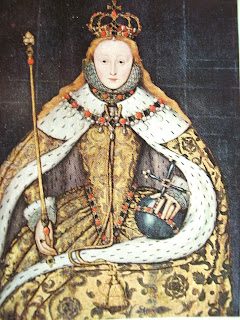ห่านป่าที่กระพือปีกกลับรังในยามสนธยาแทบฝ่ากระแสลมไปไม่ไหว
ในมหาสมุทรทิศตะวันตก มีลมและไซโครน ทำให้ท้องทะเลปั่นป่วน หอบน้ำเป็นเกลียวพวยพุ่งจากผิวน้ำ
พวยพุ่งเป็นลำและแตกกระเซ็นเป็นฟองฟู ต้นไม้ล้มระเนระนาดบนภาคพื้นแผ่นดิน Sycamore เป็นต้นไม้จำพวก Ficus sinvsycomorus หรือ occidentalis มีลักษณะทางตะวันตก
เป็นต้นไม้เนื้อแข็ง และมีลำต้นแยกเป็นสองต้น
และแต่ละต้นก็ส่งเสียงคำรามเข้าใส่กัน
กิ่งไม้ถูกลมฝนกระหน่ำหักพาดลำต้นแน่นิ่งอยู่กับพื้นดินทำให้ฝูงนกบินถลาร่อนขนานพื้นทำให้กรงเล็บของแต่ละตังคลี่ตัวออกมาทำหน้าที่เป็นคล้ายสมอเรือรบเหยี่ยว
เพเรกกิน เกาะอยู่บนหน้าผาขนเปียกชุ่มจนลู่แนบลำตัว
ใต้บานประตูของปราสาท
ลมกระแทกใส่เสื่อกกปูพื้น ส่งเสียงวาบวินอยู่ภายใต้บันใดเวียน
เขย่าบานเกร็ดสั่นสะเทือนผ่านหน้าต่างกระจกหนา หอคอยสั่นสะเทือนเหมือนเสียงดนตรี
ลาคอนชาโต้ขนานกับสายลม
กระทบคลื่นเสียงผ่านแนวระนาบสัมผัสพรมปักด้วยดิ้เงินแวววาวดังกระหึ่มเหมือนมีเครื่องสายนำโดยแชลโล่ของ
นักแต่งเพลงชื่อดัง *มารี มายรัส* ในเพลง *ระฆังของเทพยดา จีนิวีบ*....
บอร์ส
และ เบลโอเบรีสกำลังหมอบเหนือกองไฟลุกโพลง เหมืนในภาพวาด..
*แต่ทำไมพวกเขาไปกันเร็วนักเล่า*
บอร์สถามอย่างมีข้อกังขา
*ข้าไม่เคยเห็นกองทัพที่ไหนยกกำลังมาล้อมเมืองไว้แต่ก็ยกทัพกลับอย่างรวดเร็วขนาดนั้น
โดยที่พวกเขารื้อถอนค่ายไปเพียงแค่ชั่วข้ามคืนหายไปหมดเหมือนถูกลมหอบไป*
*คงจะได้ข่าวร้าย
คงจะต้องมีเรื่องไม่ชอบมาพากลในอังกฤษเกิดขึ้นก็เป็นได้*
*ถ้าพวกเขาต้องการยกโทษให้ลานสล๊อตก็คงส่งสาสน์มาแล้ว*
*ดูแปลกอยู่หรอกโดยกลับไปปุบปับโดยไม่บอกกล่าว*
*เจ้าคิดว่าอาจเกิดกบฏขึ้นใน
คอร์นวอลล์ หรือเปล่า หรือในเวลล์หรือบางทีในไอร์แลนด์*
*มีพวกบรรพชนอยู่นี่นา*
เบลโอเบรีสเห็นพ้องออกอาการมึนงง
*ข้าไม่คิดว่าเป็นเรื่องกบฏนะ
ข้าคิดว่าพระราชาทรงประชวร และต้องอัญเชิญกลับโดยด่วน หรือไม่การเวกต้องป่วยหนัก ที่โดนลานสล๊อตฟาดด้วยโล่
ให้เป็นกำนัลถึงสองครั้ง อาจจะโดนที่ศิรษะของเขาอย่างจัง*
*ก็เป็นได้*
บอร์สเคาะไฟแรงๆ
*จากไปแบบนั้น แล้วก็ไม่พูดอะไรสักคำ*
*ทำไมลานสล๊อตไม่ทำอะไรบ้างละ*
*จะให้เขาทำอะไรได้*
*ไม่รู้สิ*
*พระเจ้าอยู่หัวขับเขาออกจากประเทศนี่*
*ใช่*
*ง้นก็ไม่มีอะไรให้ทำเลย*
*ถึงอย่างไร*
เบลโอเบริส กล่าว *ข้าก็หวังว่าเขาจะทำอะไรบ้าง*
ประตูที่ตีนบันไดเปิดออกพร้อมด้วยเสียงย่ำบันไดเวียนลงมาจากหอคอยเล็ก
พรมทำด้วยต้นกกตั้งตรงขึ้น ควันพวยพุ่งจากกองไฟในเตา
และเสียงของลานสล๊อตดังรอดเสียงลมลั่น
*บอร์ส เบลโอริส เดมาริส*
*อยู่ตรงนี้*
*ตรงไหน*
**บนนี้
ได้ยินเสียงประตูปิดดังมาไกลๆ ความเงียบกลับเข้ามาในห้อง เสื่อทอต้นกกล้มลงพื้นกลับเข้าที่เดิม
และเสียงฝีเท้าของลานสล๊อตดังชัดเจนขึ้นสะท้อนก้องตามขั้นบันใดหิน ทั้งๆที่เมื่อสักครู่เสียงตะโกนของเขาฟังแทบไม่ออก
เขาเข้ามาอย่างรีบร้อนมือถือจดหมาย ลั่นเสียงกระแอมไอ *บอร์ส เบลโอริส เดมาริส*
*ข้าตามหาเจ้าอยู่*
*มีจดหมายมาจากอังกฤษ*
พวกเขายืนขึ้น
*นกส่งสารถูกพัดขึ้นฝั่ง ไกลจากชายฝั่งที่นี่ขึ้นไปห้าไมล์*
*เราต้องออกเดินทางทันทีเลย*
*”ปอังกฤษหรือ*
*ใช่*
*ฬว่
ไปอังกฤษซิ ข้าได้บอกไลน์โอแนล ให้จัดการเรื่องพาหนะแล้ว
และข้าต้องการให้เจ้า บอล์ส จัดการเรื่องเสบียงนะ*
*เราต้องรอให้กำลังลมอ่อนตัวลงก่อน*
*เราจะไปทำไมหรือ*
บอล์สถาม *ท่านต้องบอกเราว่ามีข่าวอะไร*
*ข่วหรือ*
*ข่าหรือ*
เขาพูดตะกุกตะกักสุ้มเสียงคลุมเครือ
*ยังไม่มีเวลาสำหรับช่าวหรอก
ข้าจะเล่าให้ฟังในเรือ เอ้า อ่านจดหมายนี่ก่อน*
เขายื่นจดหมายให้บอล์ส
แล้วออกไปก่อนที่พวกเขาจะทันตอบ *ว่าไง*
*อ่านสิ*
*ข้าไม่รู้ว่าใครเขียนมาด้วยซ้ำ*
*อ่านไปก็คงรู้เองน่า*
ลานสล๊อตกลับเข้ามาก่อนที่พวกเขาจะอ่านได้ไปไกลกว่าวันที่
*เบลโอโบริส*เขาบอก *ข้าลืมไป
ข้าต้องการให้เจ้าดูแลเรื่องม้า เอาจดหมายมาก่อน ถ้าเจ้าสองคนค่อยๆสะกดละก็
เจ้าต้องอ่านอยู่ทั้งคืนแน่*
*เขียนมาว่าอย่างไรละ*
*ข่าวนี้มาจากนกสื่สาร
ดูเหมือนว่า มอร์เดร๊ดเป็นกบฏต่อพระเจ้าอาณ์เธอร์ ประกาศตนเป็นประมุขแห่งอังกฤษ
และเขาได้ขอให้ วอนีเวียร์ แต่งงานกับเขา*
*แต่นางแต่งงานแล้วนี่*
เบลโอเบรีสท้วง
*นั่นเป็นสาเหตูที่พวกนั้นเลิกปิดล้อมพวกเราไง*
*แล้วดูเหมือนว่ามอร์เดร้ดยกทัพไปรวมที่เค็นต์
เพื่อขัดขวางไม่ให้พระเจ้าอยู่หัวขึ้นฝั่ง*
*เขาประกาศไปว่าพระเจ้าอาร์เธอร์ทรงสวรรคตแล้ว*
*เขากำลังล้อมจับพระราชินีโดยระดมยิงปืนใหญ่ไปที่หอคอยแห่งลอนดอน*
*ปืนใหญ่*
*ใช่
เขามารอพบอาร์เธอร์ที่โดเวอร์ และทำการสู้รบเพื่อมิให้พระองค์ขึ้นฝั่ง สู้กันทั้งบนบกและในน้ำ
แต่พระเจ้าอยู่หัวทรงขึ้นฝั่งได้ รอวันประกาศชัยชนะ*
*ใครส่งจดหมายมา*
ลานสลอ๊ตทรุดตัวลงนั่งทันที
*มาจาก ขุนพลการเวก*
*การเวกที่น่าสงสาร
เขาตายแล้ว*
เบลโอเบริสตั้งกระทู้
*ตายแล้วเขียนได้อย่างไร*
*สารนั้นอ่านแล้วน่าสลดใจเหลือเกิน*
*การเวกเป็นคนดี
พวกเจ้าทุกคนที่บังคับให้ข้าสู้กับเขา โดยไม่ได้เห็นแก่จิตใจที่งดงามของเขา*
*อ่าซิ* ฮอร์สบอกกล่าวอย่างร้อนใจ
*ดูเหมือนว่าแผลที่ข้าฟาดหัวเขามันฉกรรจ์มาก
เขาไม่ควรจะรีบเดินทางไปหรอก แต่เขาว้าเหว่ทุกข์ทรมานและถูกหักหลัง*
น้องชายคนเล้กกลายเป็นคนทรยศ เขายากรานจะกลับไปช่วยพระเจ้าอยู่หัว ในศึกตอนขึ้นฝั่ง
เขาพยายามจะสู้ เคราะห์ร้ายเขาถูกตีซ้ำตรงลอยแผลเก่า และเสียชีวิตในอีกสองสามชั่วโมง
ต่อมา
*ข้าไม่เห็นว่าทำไมเจ้าถึงต้องเดือดร้อนขนาดนี้*
*ฟังจดหมายนี่สิ*
*ลานสลอ๊ต
ถือจดหมายไปที่หน้าต่างและเงียบลง ขณะที่พินิจดูจดหมาย
มีอะไรที่หน้าตื้นตันอยู่ในนั้น*
*แต่เซอร์ลานสล๊อต
ยอดอัศวินผู้สูงส่งโดยที่ข้าได้ประจักษในชีวิตของข้า ข้า-เซอร์การเวก
อัศวินโต๊ะกลมโอรสของพระเจ้า ล๊อต แห่งอ๊อกนีย์
บุตรแห่งพระเชษฐ์ภคินีแห่งพระเจ้าอยู่หัวอาณ์เธอร์ผู้ประเสริฐ
ขอแสดงความเคารพมายังท่าน*
*และข้าขอให้โลกทั้งโลกตระหนักว่า
ข้าเซอร์การเวก ขอตายด้วยน้ำมือของท่าน และมิใช่ด้วยเจตนาของท่าน แต่เป็นเจตจำนงของข้าเอง ข้าขอวิงวอนให้ท่าน เซอร์ลานสล๊อต
กลับสู่ราชอาณาจักรแห่งนี้อีกครั้ง เพื่อมาเยี่ยมหลุมศพของข้า
และสวดภาวนาให้แก่หลุมศพที่ข้านอนรอคอยท่านอยู่โปรดภาวนาให้แก่ดวงวิญญาณของข้าด้วยข
และวันนี้ที่ข้าเขียนสาสน์ฉบับนี้
ข้าบาดเจ็บถึงฆาตด้วยบาดแผลที่มาจากน้ำมือท่าน เซอร์ลานสล๊อต ด้วยข้าพอใจที่จะไม่ถูกสังหารด้วยบุคคลผู้ประเสริฐไปกว่านี้อีกแล้ว.
*นอกจากนั้น เซอร์ลานสล๊อต
เพื่อความรักที่มีอยู่ระหว่างเรา....*
ลานสล๊อต
หยุดอ่านและโยนสาสน์ลงบนโต๊ะ *เอา* เขาบอก *ข้าอ่านต่อไปไม่ไหวแล้ว
เขาขอให้ข้ารีบเดินทางไปเพื่อช่วยพระเจ้าอยู่หัวต่อสู้กับน้องชายของเขาและญาติคนสุดท้ายของเขา
การเวกรักญาติของเขามากนะ บอร์ และท้ายที่สุดเขาก็ไม่เหลือใครเลย แต่เขายังเขียนมายกโทษให้ข้า
เขาบอกด้วยซ้ำว่าเป็นความผิดของเขาเอง
พระเจ้าทรงทราบว่าเขาเป็นพี่ชายที่ดีเหลือเกิน*
*แล้วเราจะทำอย่างไรเรื่องพระเจ้าอยู่หัว*ฃ*เราต้องไปอังกฤษให้เร็วที่สุดเท่าที่จะทำได้
มอร์เด็รดถอยทัพไปที่แกรนเบอรี่แล้ว
เขากำลังจะออกศึกครั้งใหม่ที่นั่น
ตอนนี้มันอาจจะจบลงแล้วก็ได้
ข่าวนี้มาถึงล่าช้าเพราะติดพายุ ทุกสิ่งทุกอย่างขึ้นอยู่กับความเร็วแล้ว*
/เบลโอเบริสบอกว่า
*ข้าจะไปดูเรื่องม้า
เราจะออกเรือกันเมื่อไหร่*
*พรุ่งนี้ คืนนี้ เดี๋ยวนี้เลย
เมื่อลมซาลง เร็วเข้าเถิด*
*แล้วเจ้านะบอร์ส เรื่องเสบียง*
*ตกลง*
บอร์สซึ่งเหลืออยู่คนเดียวกับลมพายุ
หยิบจดหมายขึ้นมาอย่างกระหายไคร่รู้ เขาตะแคงจดหมายลงรับแสงไฟทีเริ่มจะอ่อน
เขาสะกดตอนท้ายจดหมาย ปากขยับอ่านคำ
*และวันที่ข้าเขียนจดหมายฉบับนี้
เพียงสองชั่วโมงครึ่งก่อนความตายมาถึง เขียนด้วยลายมือของข้าเอง
และจารึกนามไว้ด้วยเลือดจากหัวใจข้า
การเวกแห่งอ๊อกนีย์*
The Earl of Essex, plotted revenge on February 8, 1601m he rode from his house in the Strand into the city in an attempt to rouse the citizens of London to rebellion. Instead the city gates shut upon him. The death of Essex, last of the courtiers who had fascinated their sovereign, Elizabeth I, marked the end of an era.






















